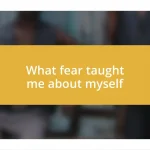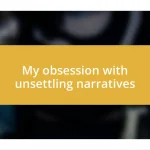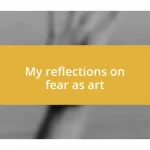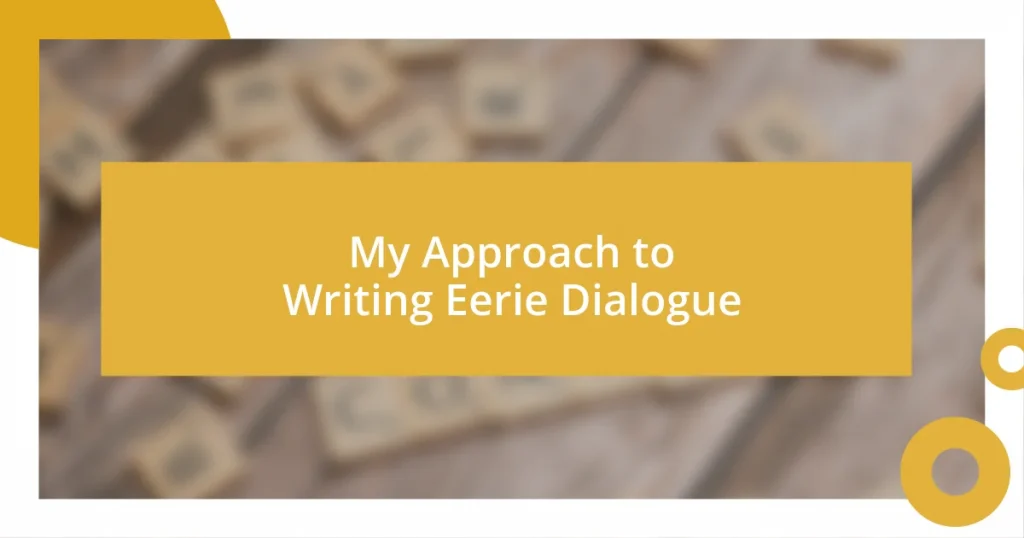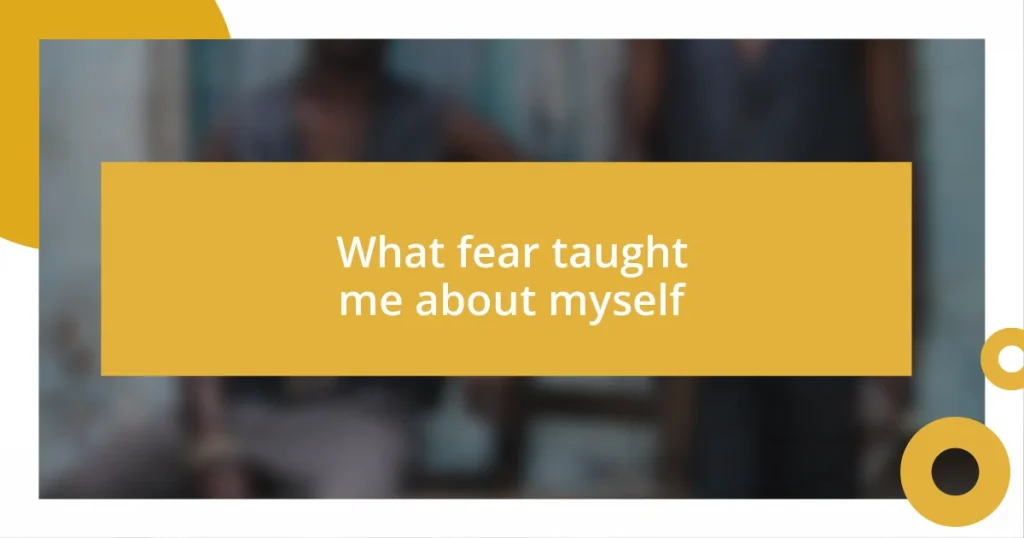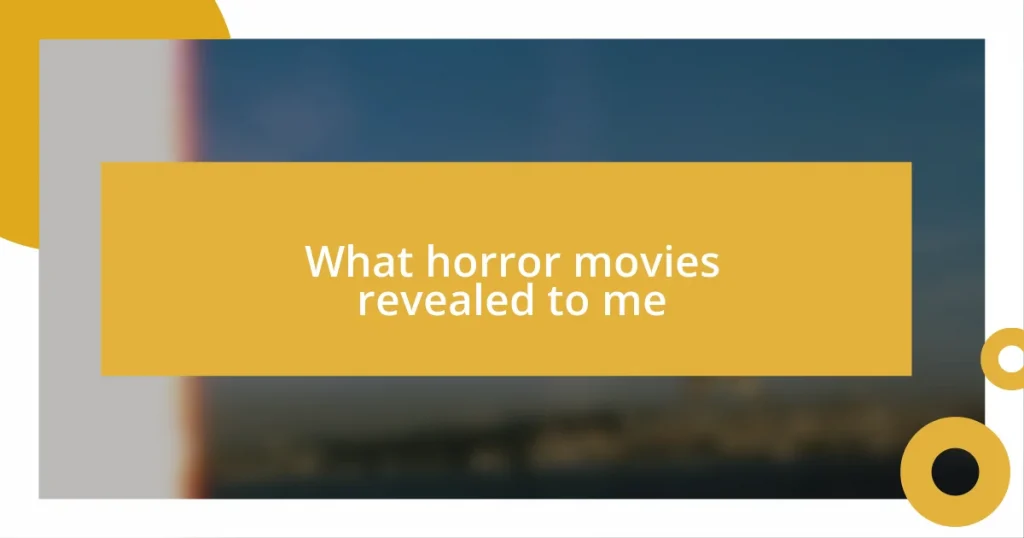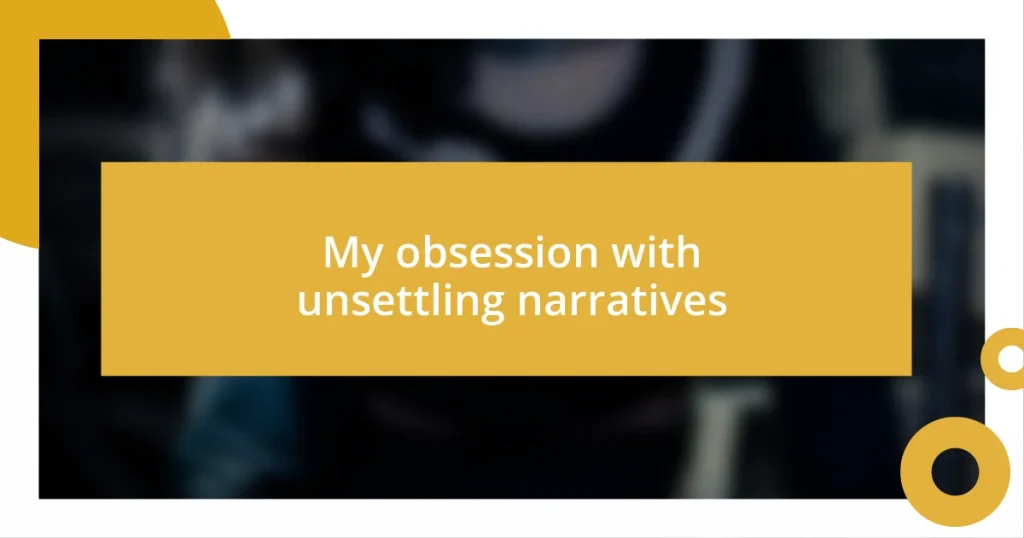Key takeaways:
- Utilizing ambiguity and pacing in dialogue can create a sense of dread and urgency, allowing readers to engage their fears.
- Word choice is crucial for evoking fear, employing evocative imagery and unexpected phrases to enhance discomfort and tension.
- Silence, pauses, and the use of unreliable narrators deepen the eeriness of dialogue, inviting readers to question reality and engage more profoundly with the text.

Understanding Eerie Dialogue Techniques
Eerie dialogue often hinges on the use of ambiguity. I remember crafting a scene where a character whispered, “Are you watching me, too?” The chill of that simple question transformed a mundane exchange into one laden with dread. It made me realize how crucial it is to leave some threads untied, allowing the reader to fill in the gaps with their fears.
Another technique I find effective is the manipulation of pacing. In one of my stories, I deliberately had the characters speak in jarringly short sentences during a tense moment. This rhythm created a sense of urgency that mirrored their escalating anxiety. Have you ever noticed how a sudden pause can make the heart race? It’s in those silences—between the words—where tension often thrives.
Lastly, the choice of words plays a pivotal role. Using familiar language in an unsettling context can be profoundly disorienting. For instance, when a character sweetly asks, “Will you come play with me forever?” it unsettles me even now. It’s fascinating how the innocence of a child’s voice can evoke such fear, isn’t it? Each word should serve a purpose, layering unease with every utterance.
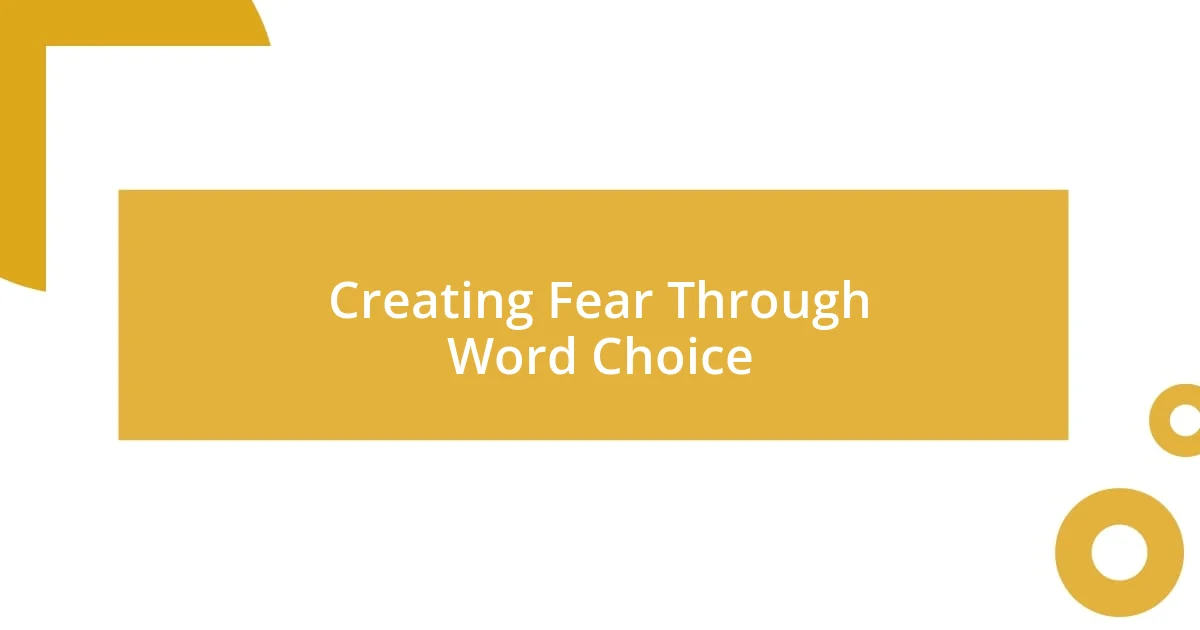
Creating Fear Through Word Choice
Selecting the right words is everything when it comes to instilling fear. I once chose to describe a character’s movements as “slithering” instead of “walking,” which completely changed the reader’s perception. That one shift evoked a visceral reaction; it turned a simple action into something sinister and almost serpentine. It’s incredible how a single word can reshape the atmosphere of a scene.
To effectively create fear through word choice, consider these points:
- Evocative Imagery: Use words that paint vivid and unsettling pictures.
- Contrasting Language: Pair innocent expressions with dark undertones to create dissonance.
- Sensory Details: Engage the senses with words that evoke smell, touch, or sound in eerie contexts.
- Unpredictability: Incorporate unexpected phrases that jolt the reader into alertness, breaking their expectation of normalcy.
- Symbolism: Choose words that have deeper meanings, allowing readers to read between the lines and tap into their own fears.
When I implemented these strategies in my own work, I discovered that the more I focused on the nuances of language, the more powerfully I could craft truly chilling dialogue that lingers in the mind long after the story ends.

Building Tension with Sentence Structure
When I think about building tension through sentence structure, I can’t help but reflect on how the formation and length of sentences affect the overall mood. Short, choppy sentences can evoke a sense of panic or urgency, capturing the reader’s attention in critical moments. For instance, in a recent story, I alternated between long, drawn-out descriptions of a character’s internal struggle and abrupt, unfinished thoughts during a climactic scene. This oscillation not only heightened the suspense but also mimicked the chaotic thoughts racing through the character’s mind.
Conversely, longer sentences can build suspense by stretching out the moment, luring the reader deeper into the eerie atmosphere. I remember writing a scene where a character scared another by revealing a dark secret, and I chose to weave the confession into a lengthy, winding sentence. The anticipation created by this structure allowed the weight of the revelation to truly sink in. The reader’s heart seems to race, waiting for that inevitable twist. Isn’t it fascinating how carefully constructed sentences can manipulate emotions so effectively?
Additionally, incorporating punctuation strategically can enhance tension dramatically. I often use dashes or ellipses to signify hesitation or contemplation. In a particularly chilling scene, I wrote, “He stood there… not moving, just watching.” The pause created by the ellipsis invited uncertainty, making the reader wonder what would happen next. This interplay of structure and punctuation adds layers to dialogue, making it a powerful tool for instilling fear.
| Sentence Structure | Tension Impact |
|---|---|
| Short Sentences | Creates urgency and reflection of panic. |
| Long Sentences | Builds suspense and deepens engagement. |
| Punctuation Use | Indicates hesitation and amplifies uncertainty. |

Using Characters to Amplify Eeriness
Characters play a pivotal role in amplifying eeriness within dialogue. I recall a scene where a seemingly innocent child spoke in a monotone voice, delivering chilling lines about what they had seen in the dark. The contrast between the childlike innocence and the horrifying revelation made the dialogue utterly unsettling. It’s this kind of dissonance that gets under your skin, prompting readers to question what’s truly lurking beneath the surface.
One of the most memorable characters I’ve written was a reclusive neighbor who came across as overly polite yet unnervingly observant. I crafted dialogues where he asked probing questions about the protagonist while maintaining an unsettling façade of friendliness. It led me to wonder—how often do we overlook the eccentricities of those around us? That sense of ambiguity keeps readers on edge, unsure of whether to fear or trust the character, which opens the door for deeper psychological exploration.
In my experience, using flawed characters with hidden secrets can amplify the eeriness of dialogue. I’ve noticed that when characters are deeply flawed or harbor dark pasts, their conversations take on an unsettling weight. For instance, I wrote a dialogue where an ex-convict casually talked about redemption, but the bitterness simmering beneath his words painted a different picture entirely. Isn’t it intriguing how the complexity of a character can change the tone of their dialogue, transforming even mundane exchanges into something haunting?

Incorporating Silence and Pauses
The power of silence and pauses in dialogue often surprises me. I’ve come to realize that a well-placed pause can convey more than words ever could. In a chilling story about a haunted house, I described a moment where two characters exchanged a meaningful glance, and then… silence fell. The absence of sound left readers hanging, built anticipation, and made them wonder what secrets lingered just beyond the edge of their understanding.
I remember a scene where the protagonist hesitated before revealing a shocking truth to a friend. By incorporating a pause here, I let the weight of the moment sink in. I chose to write, “He glanced away, the air thick with tension… then finally spoke.” This not only created a barrier for the revelation but allowed the reader to feel the dread that hung heavily between the words. Doesn’t it create a sense of involvement when a reader feels as if they too are holding their breath, waiting for the next line?
In my experience, silence often acts as a character in its own right within dialogue. During a particularly eerie exchange, a character answered a question but then fell silent, letting the stillness amplify the unspoken fears they shared. The reader, left in that unsettling quiet, can’t help but ponder what lies beneath, stirring their imagination. It’s fascinating how the interplay between silence and spoken words can draw readers deeper into the eerie atmosphere, don’t you think?

Employing Unreliable Narrators
Employing unreliable narrators can add layers of complexity to eerie dialogue that truly captivates readers. I once experimented with a character who consistently misrepresented his experiences, claiming to hear whispered secrets from the walls. It took me time to establish his perspective—was he genuinely hearing something, or was it all in his head? This ambiguity creates an unsettling tension, compelling the audience to second-guess everything he says.
I’ve found that unreliable narrators can evoke a mix of empathy and suspicion. In one story, I crafted a character who told chilling tales about an entity haunting their childhood home. As readers delved deeper, they discovered her childhood trauma, prompting me to ask—did her fears stem from genuine encounters, or were they manifestations of her disturbed psyche? This blurring of reality makes the dialogue not only eerie but also profoundly human, evoking both intrigue and discomfort.
The beauty of unreliable narrators lies in their ability to mirror our own uncertainties. I remember writing a scene where an unreliable narrator recalled a family dinner that turned sinister. The subtleties, such as his laughter and the way he twisted truths, left me pondering how our memories may not always align with reality. Isn’t it fascinating how we trust our perceptions, yet they can be so easily distorted? This introspective approach not only enhances the eeriness but also engages readers on a deeper level, forcing them to confront their own interpretations of truth.

Editing for Maximum Impact
Editing is where I truly believe eerie dialogue comes to life. When I revise my work, I focus on carving out unnecessary words that may dilute the suspense. For instance, I once had a passage brimming with description, but after several rounds, I stripped it down to a haunting line that read, “The shadows whispered secrets.” This one-sentence edit transformed the scene, allowing readers to feel the chill without being overwhelmed by exposition.
I also find that assessing the rhythm of each line can elevate tension tremendously. I recall a moment when I tweaked a dialogue exchange between two characters to span two short statements in rapid succession, followed by a longer, drawn-out reflection. This pacing not only enhanced the emotional stakes but led readers to hang on the words, anxiously awaiting what would be revealed next. Isn’t it thrilling to feel the pulse of tension through carefully crafted sentences?
Moreover, I love to experiment with the ending of each line. Sometimes, a single word can shift the meaning and emotional weight, making the dialogue linger in the air. In a recent edit, I changed a character’s final line from “I can’t believe you did that” to “I can’t believe you’d hurt me.” That subtle shift invited the reader to reflect on the deeper implications of betrayal. I wonder how often we overlook the power of a few well-chosen words in dialogue. Wouldn’t you agree that each edit is a chance to deepen the reader’s experience?
